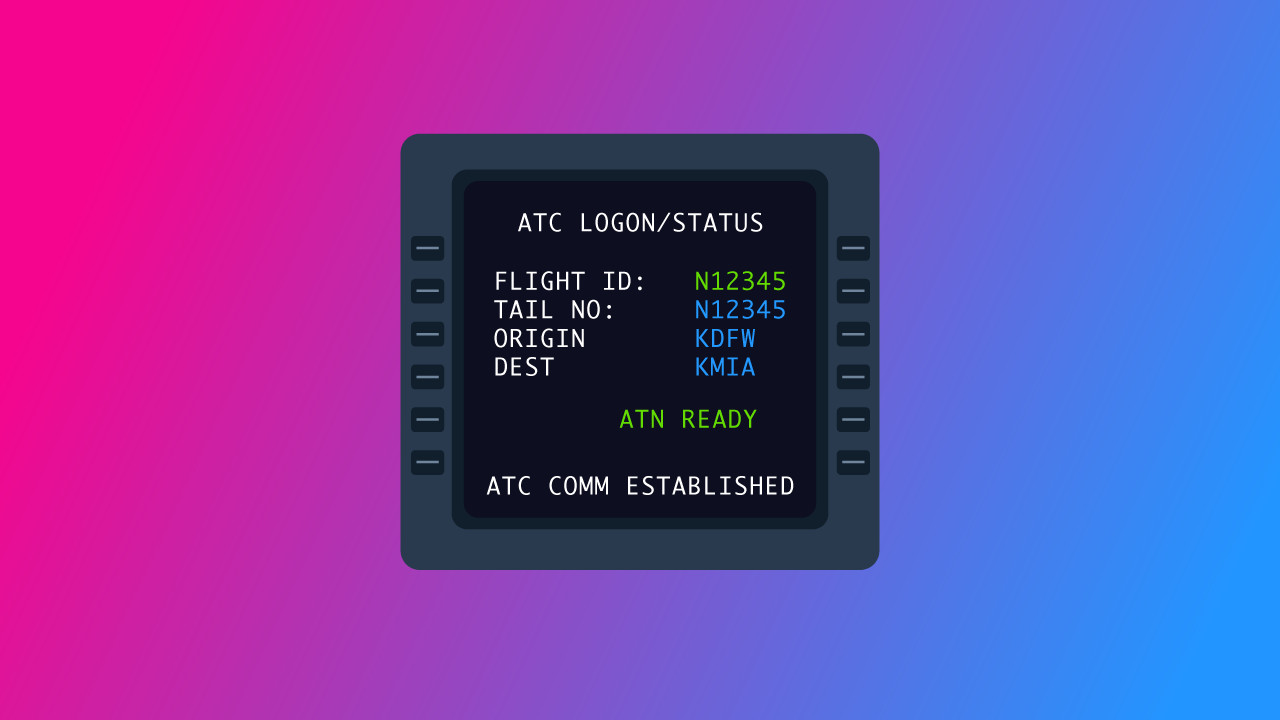-
Key Takeaways
-
What Is ACARS?
- Developing ACARS
-
How Does ACARS Work?
- Components of the ACARS System
- Communication Methods
- Data Transmission Process
-
Functions and Features of ACARS
- Operational Messaging
- Air Traffic Control Communications
- Maintenance Data Reporting
- Weather Updates and D-ATIS
- Other Uses
-
Benefits of ACARS in Aviation
- Enhancing Flight Safety
- Improving Operational Efficiency
- Reducing Pilot Workload
-
ACARS and Modern Technologies
- CPDLC
- ADS-C
-
Challenges and Limitations of ACARS
- Bandwidth and Data Limitations
- Security Concerns
-
The Future of Aircraft Communication Systems
-
Conclusion
Do you ever listen to aviation radio calls and wonder why aircraft still rely on something as old-fashioned as radio?
After all, text messages and chats overtook phone calls once we got the Internet. Did aviation develop something similar?
It did! Modern aircraft have a system called ACARS that sends text messages to ground systems. Let’s explore what ACARS is and why it’s so important for aircraft.
Key Takeaways
- ACARS lets you send short text messages between aircraft and ground stations.
- It can use VHF, HF, or satellite communication systems to transfer your message.
- Some aircraft systems can send automatic maintenance messages to ground crew.
- ACARS can replace tasks such as pre-departure and oceanic clearances, send position reports, and grab weather data for you.
What Is ACARS?
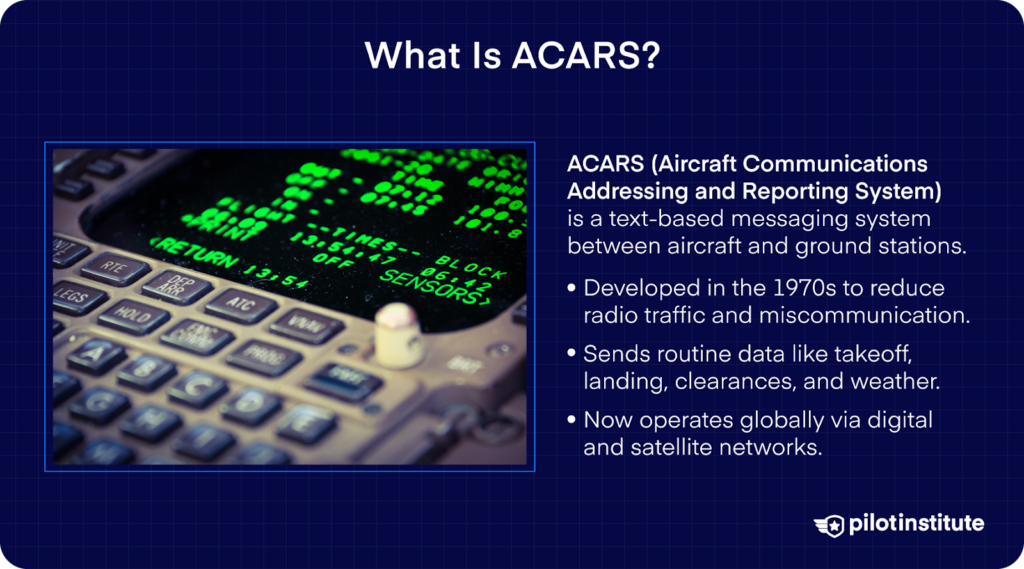
ACARS stands for Aircraft Communications Addressing and Reporting System.
Here’s the simplest way to understand ACARS: It’s a way to send text messages between an aircraft and ground stations.
But why would an aircraft need a text messaging system? After all, using a radio to communicate seems a lot simpler and faster.
Developing ACARS
Early flight crews had little choice but to relay information through voice radio, often over poor-quality signals or dealing with heavy accents and background noise.
This worked when the skies weren’t too busy, but aviation was booming by the 1970s and ‘80s. We had to find a way to reduce radio calls and eliminate errors from misheard transmissions.
ARINC (Aeronautical Radio, Inc.) developed ACARS in the late 1970s. ACARS let aircraft send routine, repetitive messages via text so they didn’t have to hold up busy radio frequencies.
Initially, this just included simple data like when the aircraft pushed back from the gate, took off, and touched down.
Before long, everything from oceanic clearance requests to in-flight weather updates could flow through ACARS.
Over time, ACARS migrated from old-school analog systems to digital and expanded through satellite networks to reach every corner of the planet.
How Does ACARS Work?
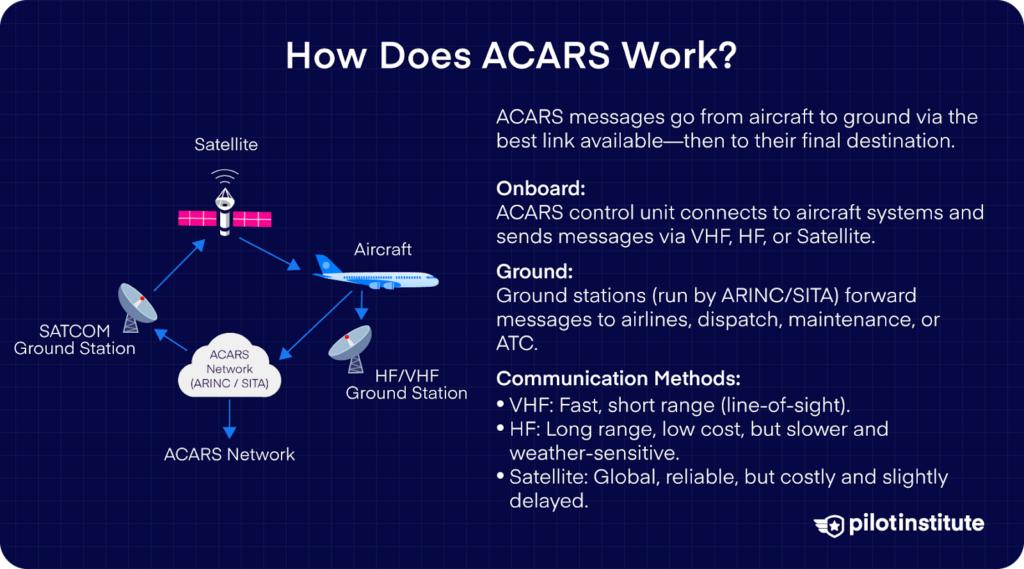
Components of the ACARS System
An ACARS setup is basically made up of two parts: systems onboard the aircraft and those on the ground.
Onboard Systems
First, there’s the ACARS control unit, which organizes messages and talks to various aircraft systems. Pilots see these messages on cockpit screens, such as the FMS interface, or get printouts from a small built-in printer.
In modern aircraft, the control unit connects with sensors on doors, parking brakes, and wheels, which tell it when to trigger automatic messages.
Then, the antennas and radio systems send the information off the airplane. This includes VHF, HF, or satellite receiving and transmitting equipment.
Ground Systems
The ground side has a network of ground radio stations or satellite receivers.
Data link service providers (like ARINC or SITA) operate these networks. They forward the messages onwards to airline operation centers, flight dispatch, maintenance facilities, or ATC.
Communication Methods
How is the data sent between the aircraft and the ground stations? Three methods are available, each with its strengths and weaknesses.
VHF Data Link (VDL)
VHF is great for sending messages over relatively short distances. This range can be up to 200 nautical miles for an aircraft at cruising altitude.
The limitation is that the aircraft must be within the ground station’s line of sight. That’s not an issue if you’re flying at altitude near populated areas.
However, it can get patchy if you’re crossing remote terrain or flying at lower altitudes where the signals get blocked by terrain or obstacles.
HF Data Link (HFDL)
HF waves can reach thousands of miles since they bounce off the ionosphere. That’s useful when you’re out over the middle of the ocean with no line-of-sight possible.
The downside is HF is slower and has limited bandwidth available. Atmospheric conditions often mess with HF, which means signals might get crackly or temporarily fade.
HF was especially useful for polar region communications since early satellite networks had limited coverage there. Modern ones, such as the Iridium constellation, cover the poles as well, leaving HF as more of a backup option.
HF usage is declining these days. It’s still useful in some situations, though.
Older aircraft without Satcom capability still use HF for ACARS. HF is free to operate, so operators with lower budgets use it instead of paying high satellite service fees.
Satellite Communications (Satcom)
Modern Satcom ACARS means near-global coverage. Satcom ACARS involves beaming your data up to an orbiting satellite, which then relays it to a ground station.
That’s a long distance for the signal to travel. That’s why this type of transmission typically has a slight delay, called latency.
Satellite airtime is also fairly expensive, so operators only use it when no other option is available.
Still, satellite links are much more stable and carry much more data than HF can handle. Satcom ACARS is often the only dependable option for staying connected for flights over remote areas or situations where HF is too unreliable.
Data Transmission Process
Sending a message through ACARS is surprisingly straightforward.
- The pilots (or even the aircraft’s automated systems) compose the message. This could be a request by the pilot for updated flight schedules or an automatic maintenance alert by the aircraft.
- That packet then travels via whichever method is best (VHF, HF, or satellite) to a service provider on the ground.
- From there, it gets routed like mail to the intended recipient: an airline operations center or an air traffic control unit.
- If a ground station wants to send a message back, it uses the reverse path. ACARS is always listening for any data addressed to your aircraft.
Functions and Features of ACARS
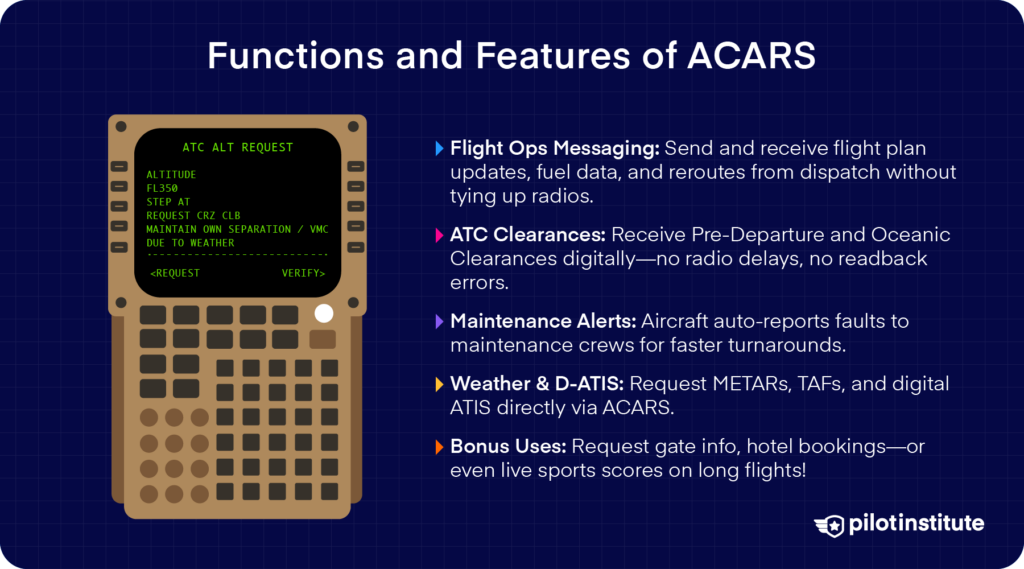
Operational Messaging
One of ACARS’ biggest jobs is keeping flight crews and airline operations teams in sync.
If you’re en route and spot a weather system building ahead, you might alert your airline’s dispatch with a quick ACARS note.
This avoids tying up the radio at a time when you may expect urgent radio calls from ATC.
Dispatch may suggest a reroute that works for their schedule. They can transmit an updated flight plan, which the pilots can input into their navigation systems.
Airline personnel on the ground can even make fuel calculations for you and transmit them via ACARS, letting you focus on flying the aircraft.
Air Traffic Control Communications
Pre-Departure Clearances
If you’ve flown out of a major airport like Atlanta or Dallas during the morning rush, you know how crowded the clearance delivery frequency can get.
Complex airspace around busy airports adds to the length of the departure clearance radio call.
With ACARS, many aircraft now receive Pre-Departure Clearances (PDC) as digital messages.
Instead of waiting for a voice radio call, you can print out or display the full clearance on your FMS. Then, you can confirm it, and you’re good to go.
This also eliminates readback errors since the message can be printed out instead of hurriedly scribbled as the controller dictates.
Plus, aircraft don’t have to wait their turn on the frequency to get a clearance. ACARS can send each aircraft their clearance simultaneously.
Oceanic Clearances and Position Reports
Pilots flying transoceanic routes are probably some of the people most grateful for ACARS.
Why? Because it frees them from using HF radio to send position reports.
HF radio is notoriously prone to static and ATC calls can be frustratingly hard to make out. ACARS helps pilots get oceanic clearances and submit position reports quickly and clearly.
Aircraft equipped with newer ACARS functions can even auto-send their position at set intervals.
Maintenance Data Reporting
ACARS isn’t just for communicating with dispatch or controllers; it’s also a direct line to the maintenance crew.
Let’s say you’re cruising toward your destination when the aircraft detects a fault. For example, if the oil pressure in one engine drops slightly but not enough to trigger a warning light, ACARS can alert the airline maintenance automatically.
By the time you land, a mechanic with the right tools is already waiting. That kind of real-time coordination saves valuable turnaround time and can prevent minor issues from becoming major delays.
One situation in which ACARS played an important role was the Air France Flight 447 crash. The aircraft automatically sent a series of ACARS fault messages throughout the flight. This helped investigators figure out what happened even before the flight recorders were recovered.
In another case, ACARS helped give investigators some clues in the disappearance of Malaysia Airlines Flight 370. The aircraft’s Satcom system (closely tied to ACARS) kept sending “handshake” signals, giving investigators enough data to estimate its final flight path.
Weather Updates and D-ATIS
ACARS can also improve relaying weather information. You can use D-ATIS instead of tuning a radio to the ATIS and waiting for the recording to complete its loop.
That’s Digital ATIS, and yes, it uses ACARS. You can use ACARS to request METARS, TAFs, or turbulence reports; it’ll instantly display what you’re looking for.
It’s helpful because you don’t have to wait to fly within radio range of the ATIS transmission or for the voice recording to go through the entire loop.
Other Uses
What can you do with ACARS when you don’t need it for flight-critical things?
Get the latest sports scores!
ACARS has a free text option that pilots on long-haul flights sometimes use to stay connected to the world below. It lets you request things from the airline’s operations center, such as connecting flight information, crew hotel bookings, and, yes, even sports scores.
Benefits of ACARS in Aviation
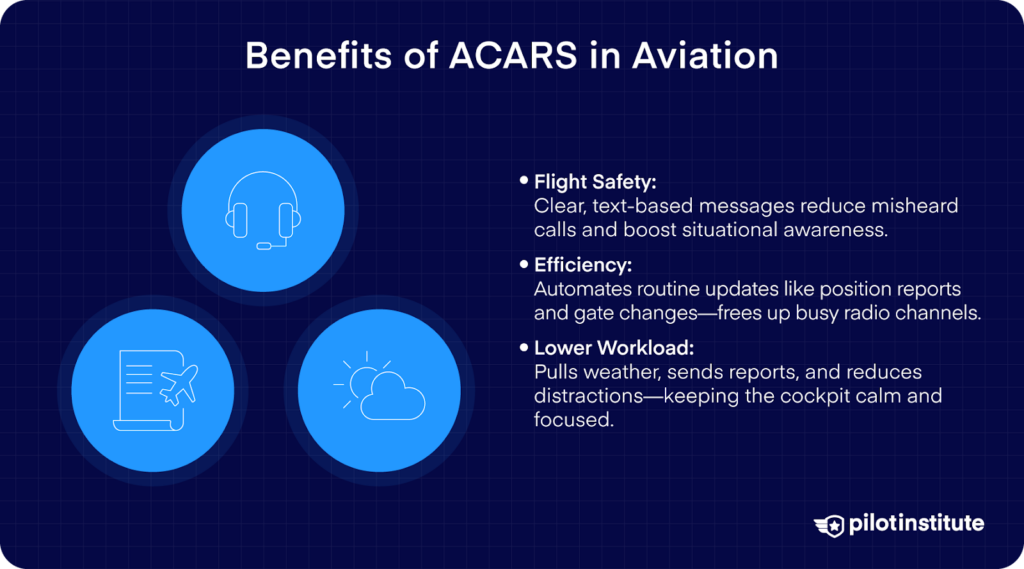
Enhancing Flight Safety
Text-based communication reduces the risk of misheard calls, especially if the frequency is jam-packed.
Having written confirmations also helps with overall situational awareness. Nobody has to wonder if that clearance was meant for them.
ACARS unambiguously lets you know that the message was addressed to you.
And since it shows up on screen or gets printed out, there’s no risk of mishearing the message or forgetting the details later.
Improving Operational Efficiency
Think about how many mundane updates flood radio channels every day: position reports, takeoff times, gate assignments.
ACARS automates or quietly handles these in the background, leaving voice channels open for more urgent communication.
The time saved on each avoided radio call may be small, but it adds up.
When you also factor in fewer mistakes and misunderstandings, it’s easy to see why aircraft operators benefit greatly from ACARS.
Reducing Pilot Workload
ACARS lets you focus on flying the aircraft by helping you out by pulling up weather data and automatically sending position reports.
Fewer radio calls mean a less chaotic cockpit and a more relaxed flight deck environment overall.
ACARS and Modern Technologies
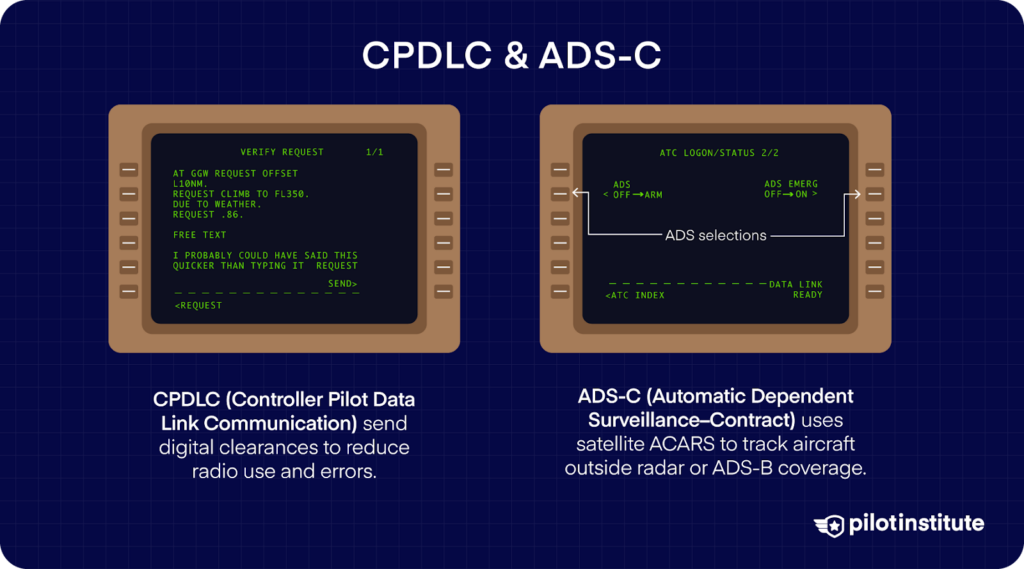
The FAA’s NextGen program is all about modernizing the national airspace system to improve efficiency and safety.
CPDLC
CPDLC, which stands for Controller Pilot Data Link Communications, is one feature that helps with this goal. One of its uses is the automated departure clearance service we mentioned earlier.
With airspace and departure procedures becoming increasingly complex, verbally delivering long clearances becomes harder and harder.
Dozens of airports now support digital clearance delivery. Pilots see the clearance appear on their FMS and, in some cases, can even load it directly into their flight plan.
We’ve already mentioned CPDLC’s use for obtaining oceanic clearances, but the FAA is now introducing it for domestic airspace as well.
ADS-C
You’ve probably heard of ADS-B before. That’s the transponder system that broadcasts your aircraft’s ID, position, speed, and other data to ATC and other aircraft.
But what happens when you fly out of ADS-B coverage?
One of the new ways ACARS helps us is through ADS-C. ADS-C uses Satcom ACARS to send periodic position reports automatically. When you’re outside ADS-B coverage, such as over an ocean, ADS-C lets ATC continue to track you.
Challenges and Limitations of ACARS
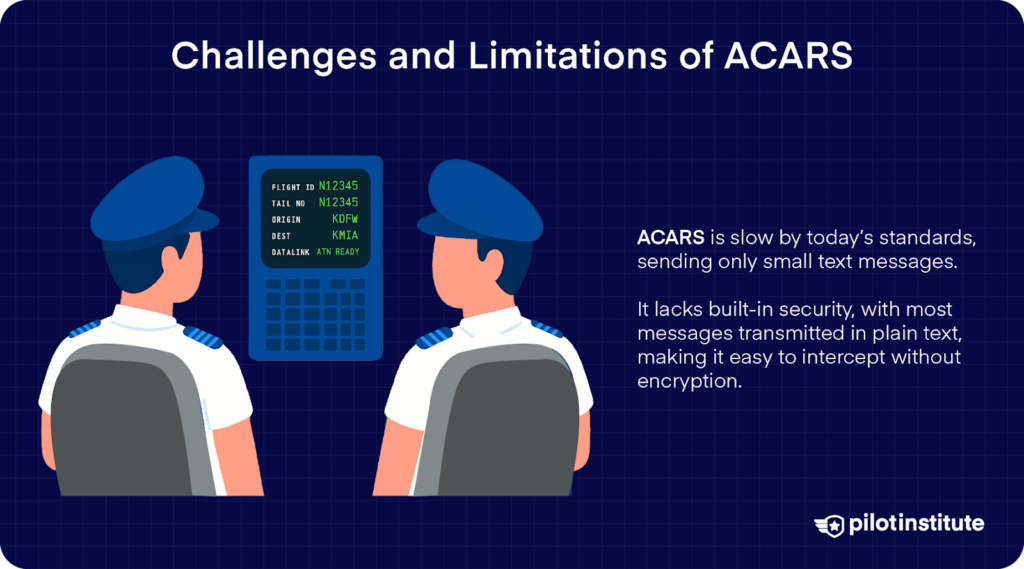
Although ACARS has been remarkably successful, it has some notable limitations due to its age and original design.
Bandwidth and Data Limitations
By modern standards, ACARS is very slow at sending data. The original ACARS VHF system operates at a rate of about 2.4 Kbps. That’s slower than dial-up Internet!
Modern ACARS versions improve that to around 32 Kbps, but that’s still only just enough to send short text messages. That means ACARS can occasionally get backed up if there are too many messages in a busy area.
After the Air France 447 accident, people considered using ACARS to constantly stream aircraft flight recorder data to the ground, sort of like an “online black box.” ACARS’ low bandwidth made that suggestion impractical, though, and so it was not implemented.
Security Concerns
Standard ACARS has little to no built-in security. Most ACARS messages are sent in plain text. That means anyone with the right radio equipment and decoder can intercept them.
In fact, aviation enthusiasts often set up ACARS receivers to capture and decode messages from airplanes overhead as a hobby.
Some military and VIP aircraft use encrypted ACARS to hide sensitive information. In general, though, ACARS was never designed with cybersecurity in mind.
The Future of Aircraft Communication Systems
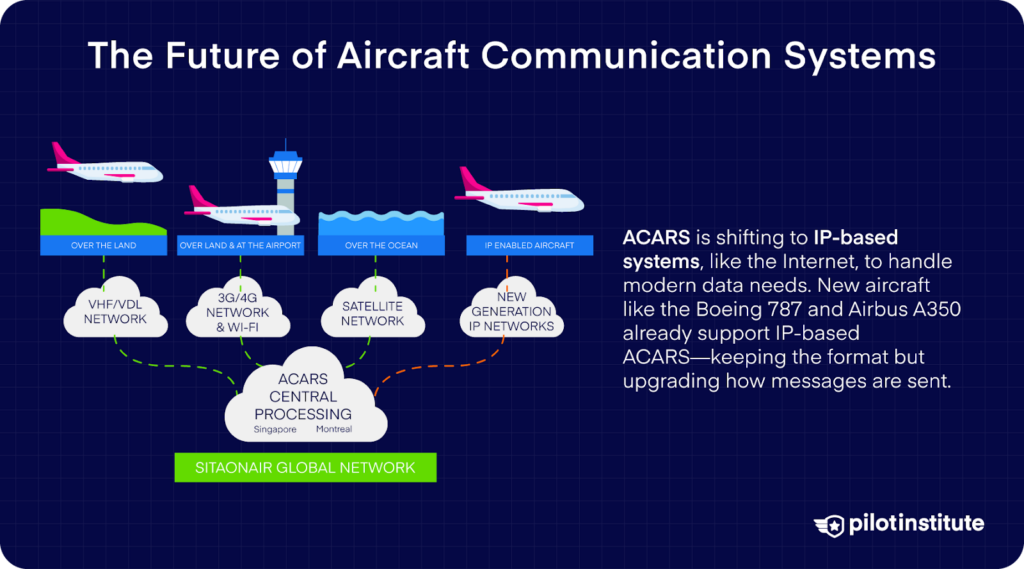
ACARS was originally intended only for small, critical messages that didn’t require much bandwidth. However, in today’s world, especially given the FAA’s push for NextGen, ACARS has to improve.
Just as the Internet moved to IP-based communication, ACARS will also transition to IP-based systems.
Future aircraft will have their own “Internet” to talk to each other, as well as to ATC and airline management. This won’t dramatically change how pilots and airlines send messages. The change is likely to happen in the technology working behind the scenes.
Where is the aviation industry right now?
Modern aircraft being delivered today have Satcom systems that support IP-based ACARS. That includes the Boeing 787 and Airbus A350.
ACARS itself isn’t going away anytime soon. These systems retain the ACARS format for now. The only difference is that they use the Internet protocol to transfer messages.
Conclusion
ACARS is a feature that isn’t widely known about modern aircraft.
Although it takes a back seat to voice communications right now, future aircraft might have their own version of the Internet.
Imagine all kinds of data streamed in real-time from every aircraft simultaneously. This vision is soon becoming a reality.
